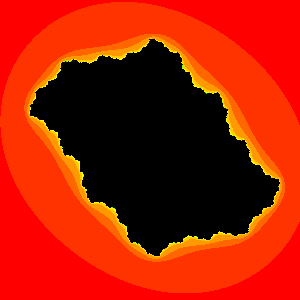
![]()

![]()

|
Question: What happens to Julia sets as c moves from the large main cardioid into one of the smaller bulbs attached to the cardioid?Answer: Two things happen. For c-values inside the cardioid, all orbits are attracted to an attracting fixed point. When c crosses into an adjacent smaller bulb (called a primary bulb), a new attracting cycle is born. At the same time, the filled Julia sets "pinch" together at various junction points in the filled Julia set. |
Click on an arrow (not stem) to see an animation of the filled Julia sets as c travels along the path shown. You must have a QuickTime player to view the animation. Click here to download a QuickTime player for Macs or PCs. Have patience while these animations are being loaded. They average around 650K per animation.
More explanation: The small white dots that suddenly appear in the animation form the points on the attracting cycle. This cycle appears as soon as c enters the small bulb attached to the cardioid. The large white dot that remains becomes a repelling fixed point when this cycle appears.
These changes are called bifurcations. Bifurcation means a splitting apart. Here we see that an attracting cycle of some period splits apart or bifurcates from the fixed point.
Further Exploration:
The Java applet below allows you to make your own movie. Simply click on a point in or near the Mandelbrot set. This gives you your starting c-value. Then click on a second c-value. This determines a path along which c will move. Click Make Movie to compute the resulting animation. Then click Play to view the movie.
Please note that your browser must be Java-enabled in order to use this applet. All recent versions of Netsapce or Internet Explorer are Java-enabled.
Dynamical Systems and Technology Project
Home Page